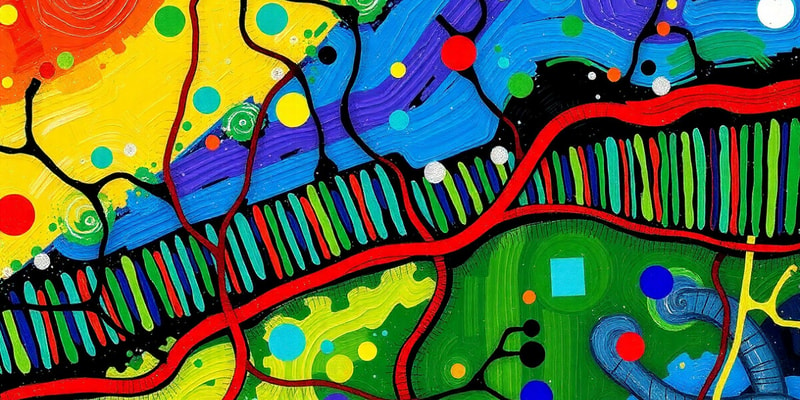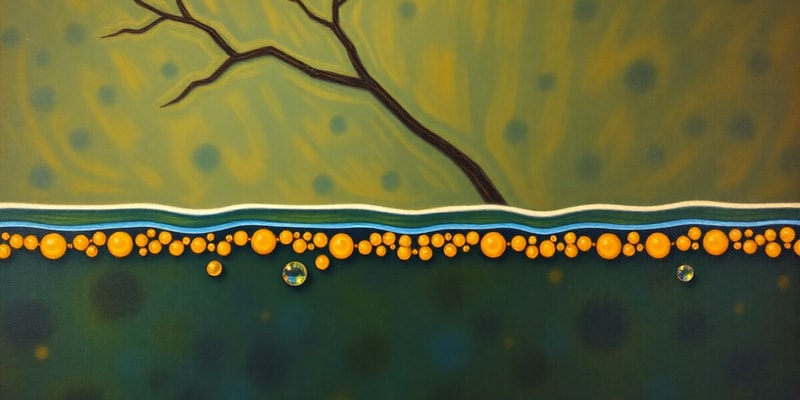Podcast
Questions and Answers
Which statement accurately describes ligand-gated channels?
Which statement accurately describes ligand-gated channels?
What role do G Protein-coupled receptors primarily play in pharmacodynamics?
What role do G Protein-coupled receptors primarily play in pharmacodynamics?
How do local anesthetics achieve their effect on nerve signaling?
How do local anesthetics achieve their effect on nerve signaling?
What is one of the main effects of benzodiazepines on the central nervous system?
What is one of the main effects of benzodiazepines on the central nervous system?
Signup and view all the answers
Which type of channels are mainly responsible for action potentials in neurons?
Which type of channels are mainly responsible for action potentials in neurons?
Signup and view all the answers
Which of the following accurately describes the mechanism of receptor-mediated drug action?
Which of the following accurately describes the mechanism of receptor-mediated drug action?
Signup and view all the answers
What distinguishes voltage-gated channels from ligand-gated channels?
What distinguishes voltage-gated channels from ligand-gated channels?
Signup and view all the answers
Which type of endogenous ligand is primarily associated with enhancing inhibitory signaling in the nervous system?
Which type of endogenous ligand is primarily associated with enhancing inhibitory signaling in the nervous system?
Signup and view all the answers
Which type of ion channel is directly controlled by the binding of a ligand?
Which type of ion channel is directly controlled by the binding of a ligand?
Signup and view all the answers
What initiates the opening of voltage-gated ion channels?
What initiates the opening of voltage-gated ion channels?
Signup and view all the answers
G protein-coupled receptors primarily transmit signals through which mechanism?
G protein-coupled receptors primarily transmit signals through which mechanism?
Signup and view all the answers
What is the primary mechanism of action for local anesthetics?
What is the primary mechanism of action for local anesthetics?
Signup and view all the answers
Benzodiazepines exert their effects primarily by enhancing which type of neurotransmission?
Benzodiazepines exert their effects primarily by enhancing which type of neurotransmission?
Signup and view all the answers
Which mechanism is NOT associated with ligand-gated ion channels?
Which mechanism is NOT associated with ligand-gated ion channels?
Signup and view all the answers
What is a common characteristic of both ligand-gated and voltage-gated channels?
What is a common characteristic of both ligand-gated and voltage-gated channels?
Signup and view all the answers
Which of the following is NOT a major function of transmembrane ion channels?
Which of the following is NOT a major function of transmembrane ion channels?
Signup and view all the answers
What is the primary effect of local anesthetics on neuronal action potentials?
What is the primary effect of local anesthetics on neuronal action potentials?
Signup and view all the answers
How do benzodiazepines function at the GABA receptor complex?
How do benzodiazepines function at the GABA receptor complex?
Signup and view all the answers
What characterizes the structure of G protein-coupled receptors (GPCRs)?
What characterizes the structure of G protein-coupled receptors (GPCRs)?
Signup and view all the answers
What is the primary neurotransmitter affected by benzodiazepines in the central nervous system?
What is the primary neurotransmitter affected by benzodiazepines in the central nervous system?
Signup and view all the answers
What happens to neurons when chloride ions flow into them due to GABA activity enhanced by benzodiazepines?
What happens to neurons when chloride ions flow into them due to GABA activity enhanced by benzodiazepines?
Signup and view all the answers
Which of the following accurately describes a function of G protein-coupled receptors?
Which of the following accurately describes a function of G protein-coupled receptors?
Signup and view all the answers
What occurs when local anesthetics bind to voltage-gated sodium channels in neurons?
What occurs when local anesthetics bind to voltage-gated sodium channels in neurons?
Signup and view all the answers
What is the role of second messengers in ligand-gated channels?
What is the role of second messengers in ligand-gated channels?
Signup and view all the answers
Study Notes
Voltage-Gated Calcium Channels
- Calcium channels facilitate the influx of calcium ions, crucial for various cellular functions.
- Channel conductance, controlled by voltage changes, influences intracellular calcium levels.
Second Messenger-Regulated Channels
- Ligand binding to G protein-coupled receptors generates second messengers that modulate ion channel conductance.
- Second messengers play a significant role in transducing signals from outside to inside the cell.
Local Anesthetics
- Act primarily on voltage-gated sodium channels in neuronal membranes.
- Blockage of sodium channels prevents action potential generation and propagation.
- Pain signal transmission to the central nervous system is inhibited, leading to pain relief.
- The blockade is reversible; normal nerve function resumes after the anesthetic is eliminated.
Benzodiazepines
- Bind to GABA receptors, enhancing GABA's effect as the main inhibitory neurotransmitter in the CNS.
- Increase chloride ion flow into neurons, causing hyperpolarization and decreased neuronal excitability.
- Produce CNS depression, resulting in sedation, anxiety reduction, muscle relaxation, and anticonvulsant effects.
G Protein-Coupled Receptors (GPCRs)
- Most abundant receptor class in the human body, with seven transmembrane domains.
- Composed of a single polypeptide chain and coupled to intracellular G-proteins (Gα, Gβ, Gγ) for signaling.
- Play significant roles in various physiological responses and drug actions.
Pharmacodynamics
- Studies the effects of drugs on the body and their mechanisms of action.
- Examines biochemical and physiological drug effects.
- Considers the relationship between drug concentration at the action site and pharmacological response.
Drug Mechanisms
- Drugs predominantly exert effects through receptor binding, simulating or inhibiting natural substances.
- Non-receptor mechanisms include altering membrane permeability, enzyme inhibition, and physical activity changes.
Protein Targets for Drug Binding
- Physiological receptors, enzymes, ion channels, transporters, and structural proteins are key protein targets.
- Receptors can be located in the cell membrane, cytoplasm, or nucleus and mediate pharmacological actions.
Endogenous Ligands
- Ligands include neurotransmitters (released by neurons), hormones (from endocrine glands), and local chemical mediators.
- Bind to specific sites on receptor proteins, influencing physiological functions.
Receptor-Mediated Mechanisms
- Classified into six major groups, including transmembrane ion channels and intracellular receptors.
- Each group has distinct roles in cellular signaling and function.
Drug and Receptor Interactions
- Drugs can alter ion channel conductance by binding to plasma membrane channels.
- Interaction pathways include extracellular binding, influencing signaling cascades, and intracellular binding for lipophilic drugs.
Functions of Transmembrane Ion Channels
- Regulate the flow of ions essential for neurotransmission, cardiac conduction, muscle contraction, and secretion.
- Mechanisms include ligand-gated channels (controlled by ligand binding) and voltage-gated channels (respond to membrane voltage changes).
Studying That Suits You
Use AI to generate personalized quizzes and flashcards to suit your learning preferences.
Related Documents
Description
Test your understanding of transmembrane ion channels and their regulation. This quiz covers key concepts like voltage-gated calcium channels and the role of second messengers in ion conductance. Dive into the mechanisms of ligand binding and G protein-coupling for a comprehensive review.




